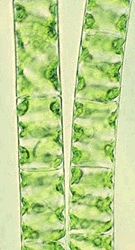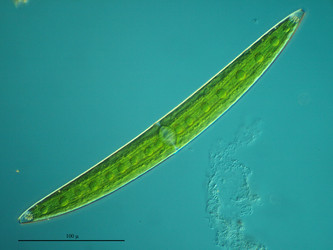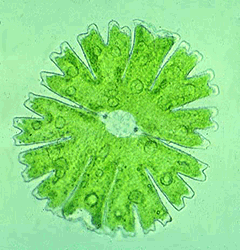Zygnematales
Richard M. McCourt


This tree diagram shows the relationships between several groups of organisms.
The root of the current tree connects the organisms featured in this tree to their containing group and the rest of the Tree of Life. The basal branching point in the tree represents the ancestor of the other groups in the tree. This ancestor diversified over time into several descendent subgroups, which are represented as internal nodes and terminal taxa to the right.

You can click on the root to travel down the Tree of Life all the way to the root of all Life, and you can click on the names of descendent subgroups to travel up the Tree of Life all the way to individual species.
For more information on ToL tree formatting, please see Interpreting the Tree or Classification. To learn more about phylogenetic trees, please visit our Phylogenetic Biology pages.
close boxIntroduction
The conjugating green algae are among the most common algae in freshwater streams, ponds, and lakes. Including such familiar algae as Spirogyra, these algae, unlike most other green algae, lack flagellated cells at any time during the life cycle. They reproduce sexually through several variations of the process known as conjugation, in which haploid vegetative cells come close together and form nonflagellated gametes that fuse to form a zygote. Meiosis occurs in the zygote and from one to four offspring emerge at germination.
The thalli (the bodies of the algae) are of various types, including single cells, filaments or chains of cells, and colonies. These algae have been observed by microscopists for over a century, for scientific interest and intrinsic beauty.
There are approximately 56 genera in five families within this group. Families of the Zygnematales are distinguished by differences in the structure of wall of the vegetative cell. The Zygnemataceae and Mesotaeniaceae have smooth, unsegmented cell walls. The wall of each vegetative cell in the Gonatozygaceae, Closteriaceae, and Peniaceae consists of two similar pieces joined in the center of the cell; these families also exhibit various sculpturing patterns and pores that penetrate through the outer wall layer. The wall of a vegetative cell in the Desmidiaceae also consists of two mirror-image parts, but the cell is deeply incised in the center where the two parts join. Wall sculpturing is more elaborate in the Desmidiaceae, and pores extend completely through the wall. The Zygnemataceae contains unbranched filamentous forms. The Mesotaeniaceae consists mostly of unicellular algae. The other three families contain unicells, filaments or chains of cells, or colonies.
Systematics of the group is summarized in Bold and Wynne (1985) and Hoshaw et al. (1990).
For summaries of studies on the natural history of these organisms, see Hoshaw (1968), Hoshaw and McCourt (1988), and Hoshaw et al. (1990).
Discussion of Phylogenetic Relationships
Morphological analyses have differed in their arrangement of the many genera in this group Classification has generally reflected underlying evolutionary hypotheses of the authors (West, 1904; West and Fritsch, 1927; Fritsch, 1935; Prescott et al., 1972). The phylogeny shown here reflects the widely accepted classification of Mix (1972, 1973), who examined vegetative wall structure in detail (see Notes about Terminal Taxa).
Molecular studies of small-subunit rDNA have generally confirm the Mix classification (Surek et al., 1993; Bhattacharya et al., 1994), although these studies and that of McCourt et al. (1995) suggest that the two families with smooth, unsculptured walls may be polyphyletic.
References
Bhattacharya, D., Surek, B., Rüsing, M., Damberger, S., and Melkonian, M. 1994. Group I introns are inherited through common ancestry in the nuclear-encoded rRNA of Zygnematales (Charophyceae). Proc. Natl. Acad. Sci. USA 91: 9916-20.
Bold, H. C. & Wynne, M. J. 1985. Introduction to the Algae. 2nd ed., Prentice-Hall, Inc., Englewood Cliffs, New Jersey, 720 pp.
Brook , A. J. 1981. The Biology of Desmids. Botanical Monographs, Volume 16, Blackwell Scientific Publications, Oxford, 276 pp.
Hoshaw et al. 1990
Hoshaw 1968
Hoshaw and McCourt 1988
Surek
McCourt et al.
Title Illustrations

| Scientific Name | Closterium |
|---|---|
| Location | Soto del Estajao de Alfaro, Rioja, Spain |
| Source | CLOSTERIUM |
| Source Collection | Flickr |
| Image Use |
 This media file is licensed under the Creative Commons Attribution-NonCommercial-NoDerivs License - Version 2.0. This media file is licensed under the Creative Commons Attribution-NonCommercial-NoDerivs License - Version 2.0.
|
| Copyright | © 2008 aguilleno |
About This Page

Academy of Natural Sciences of Drexel University
Correspondence regarding this page should be directed to Richard M. McCourt at
Page copyright © 1996
All Rights Reserved.
Citing this page:
McCourt, Richard M. 1996. Zygnematales. Version 01 January 1996 (under construction). http://tolweb.org/Zygnematales/20578/1996.01.01 in The Tree of Life Web Project, http://tolweb.org/













 Go to quick links
Go to quick search
Go to navigation for this section of the ToL site
Go to detailed links for the ToL site
Go to quick links
Go to quick search
Go to navigation for this section of the ToL site
Go to detailed links for the ToL site